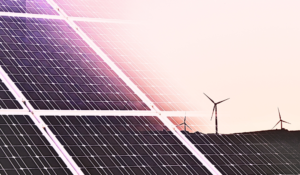Physical Address
23,24,25 & 26, 2nd Floor, Software Technology Park India, Opp: Garware Stadium,MIDC, Chikalthana, Aurangabad, Maharashtra – 431001 India
Physical Address
23,24,25 & 26, 2nd Floor, Software Technology Park India, Opp: Garware Stadium,MIDC, Chikalthana, Aurangabad, Maharashtra – 431001 India

By Aayushi Sharma
A video in a viral Twitter post shows a person stating that Green Energy causes environmental degradation. The person claims that Electric Vehicles running on Lithium-ion batteries, Wind Turbines etc., are more harmful than beneficial.
Here’s the post by user @Bel_B30
The person in the video identifies themselves as Rachel Mathew from Colchester, UK, who claims to have researched green energy and concluded that it is all a scam.
The claims
Claim 1: Wind turbines that last about 20 years consume a lot of resources and energy to manufacture and install. Also, they cannot be readily recycled.
Fact: Depending on the environmental conditions, wind turbines can last 25 years or longer. There are several options available to recycle the parts of old wind turbines.
What we found?
About Wind Energy
Wind Turbines collect and convert the wind’s kinetic energy into electricity. This helps in powering the grid. Not only is wind an abundant and inexhaustible resource, but it also provides electricity without burning any fuel or polluting the air.
Since the first commercial wind turbines went online in the middle to late 1990s, the topic of what happens to their waste materials as they approach the end of their operating lifespan and decommissioning has arisen.
How long do wind turbines last? Is it possible to extend their lifespan?
A modern wind turbine of acceptable quality can last 25 years or longer, depending on the environment and the necessary maintenance practices being followed.
When maintained well, these small-scale plants can operate for more than 30 years.
With proper monitoring and maintenance, a turbine’s lifespan can be increased. Based on the anticipated loads, fatigue, and site-specific environmental conditions, the asset’s condition must be evaluated and compared with the turbine’s exhausted lifespan.
Are the old blades of wind turbines reused or recycled?
Some people believe wind turbines are bad for the environment since some parts, including their blades, cannot be recycled.
Even though some cannot be recycled, manufacturers and operators are making enormous efforts to make them as sustainable as possible by discovering ways to recycle, reuse, or rebuild them using recyclable components in the future.
Some but not all: Even though some first-generation commercial blades are being considered waste, not all of them are going to be dumped. Their basic elements can be recycled in various creative ways to be turned into new construction materials or completely repurposed for use in different structures.
Claim 2: Lithium mine causes millions of tons of waste and human suffering. Lithium mining is causing human health degradation and child labour.
Fact: The harmful effects of mining exist but are not exclusive to lithium mining only. Lithium mining has less negative impacts compared to coal and lead mining.
About Lithium Mining
The process of extracting lithium uses significant amounts of water and energy, and lithium mining can pollute the air, land, and water (similar to any other mining) with some chemicals and heavy metals. However, sustainable mining techniques are being developed, including the utilization of renewable energy sources and a reduction in the usage of water and chemicals.
Lithium-ion batteries are an essential component in the present drive to replace gas-powered cars that create CO2 and other greenhouse pollutants. These batteries are excellent choices for grid energy storage due to their similar qualities. But doing so has a price because producing batteries and the parts that go into them produces CO2, among other environmental and societal problems. There are some social concerns of the mining sector, like child labor and degradation of human health, but that is not exclusive to lithium mining. It is a common concern for all the mining sectors that must be addressed.
What are the added advantages of lithium extraction in the long run?
The above diagram compares rechargeable battery technologies.
References:
https://www.energy.gov/eere/wind/wind-energy-basics
https://www.dw.com/en/how-sustainable-is-wind-power/a-60268971
https://www.nationalgrid.com/stories/energy-explained/can-wind-turbine-blades-be-recycled
https://www.mdpi.com/1996-1073/13/21/5847
https://www.mdpi.com/1996-1073/13/21/5847
https://climate.mit.edu/ask-mit/how-much-co2-emitted-manufacturing-batteries